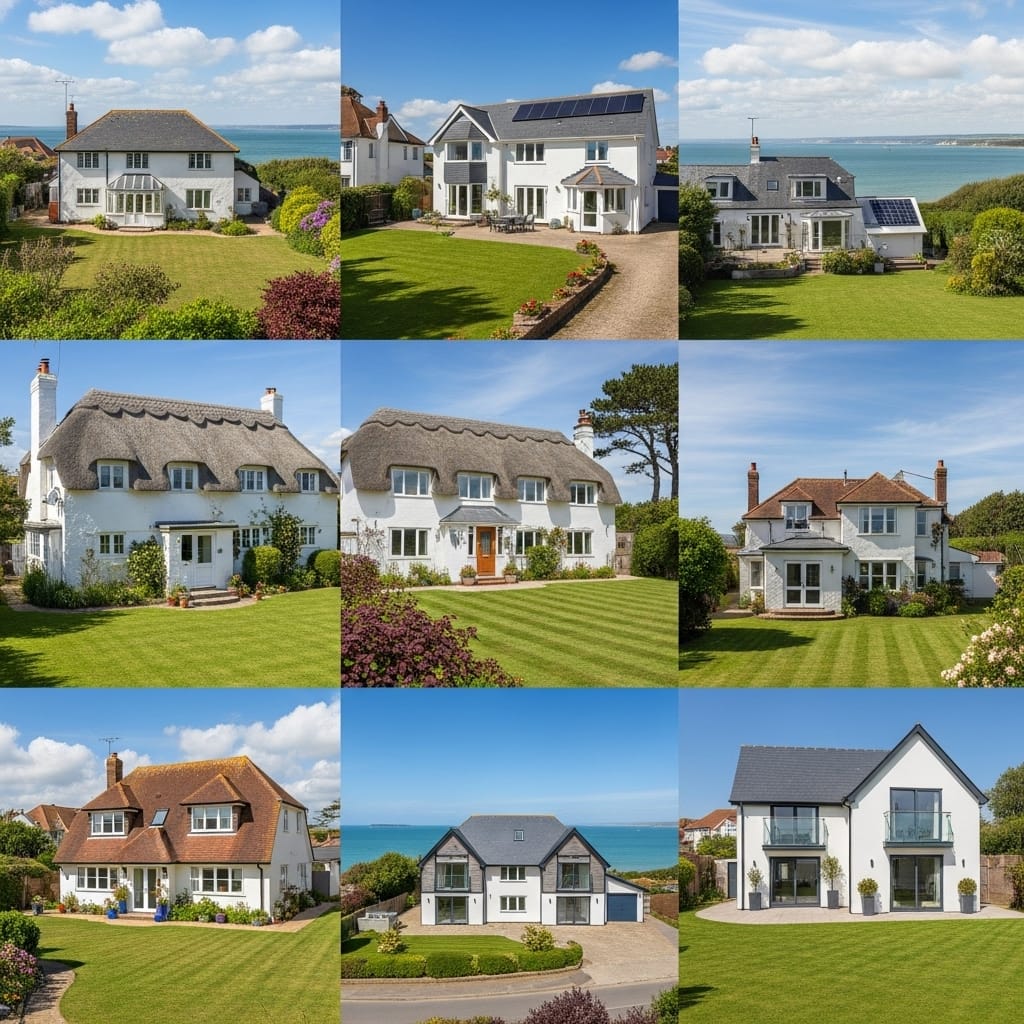
Isle of Wight Houses for Sale: Your Guide to Island Living
There’s a certain magic to the Isle of Wight, an undeniable allure that captures the hearts of holidaymakers and, for a growing number, beckons them to stay for good. Separated from the mainland by the Solent, this diamond-shaped island offers a lifestyle that feels a world away from the hustle and bustle of modern Britain. It’s a place where stunning coastline meets rolling countryside, where vibrant towns give way to quaint villages, and where a strong sense of community prevails. It’s no wonder, then, that houses for sale on the Isle of Wight are attracting more attention than ever before.
For many, the dream of island living is rooted in a desire for a slower, more mindful pace of life. It’s about swapping traffic jams for coastal walks, and crowded high streets for independent boutiques and farmers’ markets. The Isle of Wight delivers this in abundance. Yet, it’s a misconception to think of the island as a sleepy backwater. It’s a place of immense creativity, a hub for sailing enthusiasts, a paradise for foodies, and home to a thriving cultural scene, most famously embodied by the legendary Isle of Wight Festival.
Finding Your Perfect Patch: A Tour of the Island’s Property Hotspots
The beauty of the Isle of Wight property market lies in its diversity. Whether you’re a first-time buyer, a growing family, a retiree seeking tranquillity, or an investor looking for a lucrative holiday let, the island has something to offer. The key is knowing where to look. Each town and village boasts its own unique character and charm, and understanding these nuances is the first step to finding your dream home.

The North: Gateway to the Island
The northern coast of the island is the most accessible from the mainland, with regular ferry services from Southampton and Portsmouth. This makes it a popular choice for commuters and those who want to maintain strong links with the mainland.
- Cowes & East Cowes: World-renowned as the epicentre of international sailing, Cowes is a vibrant, bustling town, particularly during the summer months. Its historic high street is lined with chic boutiques, yachting outfitters, and excellent pubs and restaurants. Property here ranges from elegant Georgian and Victorian townhouses with stunning sea views to more modern developments. Across the Medina estuary, East Cowes offers a slightly more relaxed atmosphere and often more affordable property options, while still benefiting from easy access to the mainland and the attractions of its western counterpart.
- Ryde: As one of the largest towns on the island, Ryde boasts a fantastic sandy beach that stretches for miles, a historic pier, and a bustling town centre with a great mix of independent shops and high-street names. It’s a fantastic option for families, with excellent schools and a wide range of properties, from grand Victorian villas on the seafront to more modest terraced houses and bungalows further inland. The Hovercraft to Southsea provides the fastest link to the mainland, making it a viable option for daily commuters.
The West Wight: Wild and Wonderful
For those who crave dramatic landscapes, rugged coastlines, and a true sense of escape, the West Wight is an idyllic choice. This part of the island is characterised by its Areas of Outstanding Natural Beauty, chalk downs, and breathtaking coastal paths.
- Yarmouth: A picturesque harbour town with a continental feel, Yarmouth is one of the oldest settlements on the island. Its narrow streets are filled with characterful cottages, historic inns, and independent galleries. The town has a strong maritime heritage and a close-knit community. Properties in Yarmouth are highly sought after, particularly those with views of the harbour and the Solent.
- Freshwater & Totland Bay: These neighbouring villages offer a more laid-back coastal lifestyle. Freshwater Bay, with its dramatic cliffs and pebbly beach, was a favourite of the Victorian poet Alfred, Lord Tennyson. The area offers a mix of property types, from charming period cottages to modern family homes. Totland Bay boasts a beautiful sandy beach and a newly renovated pier, making it a popular spot for swimming and enjoying the spectacular sunsets.
The East and South: Classic Seaside Charm and Sunshine
The eastern and southern coasts of the island are home to some of the most popular and traditional seaside resorts, blessed with some of the best sunshine records in the UK.
- Sandown & Shanklin: These twin towns are the embodiment of the classic British seaside holiday. With long sandy beaches, traditional piers, and a plethora of family-friendly attractions, they are perennial favourites. The property market here is diverse, offering everything from seafront apartments and guest houses to spacious family homes and retirement bungalows. Shanklin, in particular, is famed for its picturesque Old Village, with its thatched cottages, tea rooms, and charming pubs.
- Ventnor: Nestled on the steep slopes of the Undercliff, Ventnor has a unique microclimate that allows subtropical plants to flourish in its renowned Botanic Garden. This Victorian health resort retains an air of elegance and charm, with its cascading terraces of period properties offering stunning views of the English Channel. The town has a burgeoning arts scene and a growing reputation for its excellent independent restaurants.
The Heart of the Island: Rural Bliss
Away from the coast, the island’s interior is a patchwork of rolling green hills, ancient woodlands, and sleepy hamlets. This is the place to find true peace and quiet, and often, more property for your money.
- Newport: As the island’s principal town and administrative centre, Newport offers a wide range of amenities, including a multiplex cinema, a variety of shops, and a bustling market. It’s a practical and central location from which to explore the rest of the island. The property landscape is varied, with historic townhouses in the centre and modern housing estates on the outskirts.
- Godshill & Arreton: These quintessential English villages are among the most photographed on the island. With their charming thatched cottages, medieval churches, and traditional pubs, they offer a glimpse into a bygone era. Properties here are full of character and are ideal for those seeking a peaceful, rural lifestyle.
The Isle of Wight Property Market: What to Expect
Like the rest of the UK, the Isle of Wight property market has experienced fluctuations in recent years. However, the enduring appeal of the island lifestyle has ensured that demand remains consistently strong. Prices can vary significantly depending on location, property type, and, crucially, whether there’s a sea view. Coastal properties, particularly those with direct water access or panoramic views, command a premium.
The market is diverse. You’ll find everything from multi-million-pound waterfront estates to modest one-bedroom flats perfect for first-time buyers. There’s a significant number of bungalows, making the island a popular choice for retirees. Period properties, from Victorian villas to thatched cottages, are also a key feature of the island’s architectural landscape and are always in high demand.
For investors, the holiday let market presents a significant opportunity. The island’s popularity as a tourist destination means that well-located and well-presented properties can generate a substantial rental income, particularly during the peak summer season and during major events like the Isle of Wight Festival and Cowes Week.
Living the Island Life: More Than Just a Home
Buying a house on the Isle of Wight is about more than just bricks and mortar; it’s about embracing a whole new way of life. It’s a life lived in tune with the seasons, dictated by the tides, and enriched by the natural environment.
The great outdoors becomes your playground. With over 500 miles of footpaths and 200 miles of bridleways, the island is a paradise for walkers, cyclists, and horse riders. The coastline offers endless opportunities for sailing, kayaking, paddleboarding, and coasteering. For nature lovers, the island’s diverse habitats, from salt marshes to chalk grasslands, are home to a rich array of wildlife, including the rare red squirrel.
The island’s community spirit is another of its greatest assets. There’s a real sense of belonging here, a feeling that you’re part of something special. This is fostered through a packed calendar of local events, from village fetes and farmers’ markets to large-scale festivals and regattas. The slower pace of life encourages people to connect, to stop and chat, and to support local businesses.
The food and drink scene is also flourishing. The island is home to an abundance of local producers, from farmers and fishermen to brewers and distillers. You can enjoy freshly caught crab and lobster, sample award-winning cheeses and chutneys, and sip on locally brewed ales and gins. The island’s pubs, cafes, and restaurants take great pride in showcasing this local larder.
The Practicalities of Moving to the Isle of Wight
While the dream of island living is compelling, there are practical considerations to bear in mind. The ferry crossing is, of course, the most significant. While services are frequent and reliable, the cost and time involved in travelling to and from the mainland need to be factored into your decision, particularly if you’ll be commuting regularly.
Employment opportunities on the island can be more limited than on the mainland, although the rise of remote working has opened up new possibilities for many. The main sectors of employment are tourism, retail, and healthcare. For those with specialist skills or entrepreneurial spirit, the island can offer a supportive environment in which to build a business.
When it comes to choosing a property, it’s essential to do your research and, most importantly, to spend time on the island. Visit at different times of the year to experience both the vibrant buzz of summer and the peaceful calm of winter. Explore the different towns and villages to find the one that feels like home. Engage with local estate agents who have an in-depth knowledge of the market and can provide invaluable advice.
Ultimately, a move to the Isle of Wight is a lifestyle choice. It’s a decision to prioritise well-being, community, and a connection to nature. For those who take the plunge, the rewards are immeasurable. It’s the joy of a morning walk along a deserted beach, the thrill of watching the yachts race on the Solent, the comfort of a pint in a centuries-old pub, and the simple pleasure of watching the sunset over the western downs. If you’re searching for a place that offers not just a house, but a home and a way of life, the Isle of Wight might just be the island you’ve been dreaming of.







